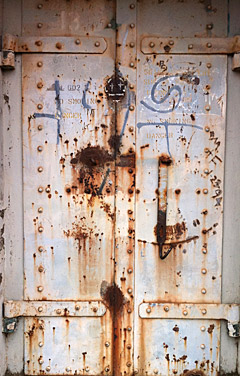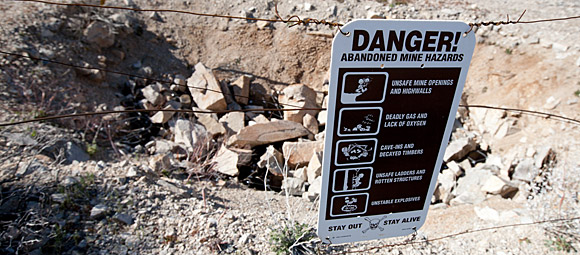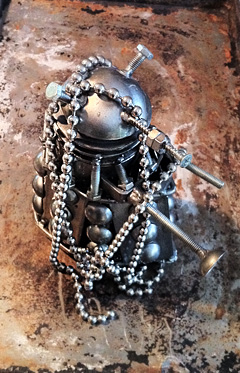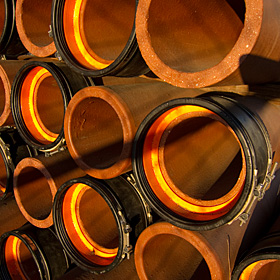Posted: August 2nd, 2011 | Author: Nathan | Filed under: field recording, sound design

Rusty? Heavy? Covered in graffiti? You KNOW it will sound good.
Many people are unaware that the San Francisco Bay Area was once thoroughly fortified against attacks from the sea. Remnants of this past dot the entrance to the Golden Gate, in the form of bunkers that once housed gun emplacements.
One such installation was Battery Yates at Fort Baker. Located at the best vantage point for southward-facing photos of the Golden Gate Bridge, Battery Yates was meant for nothing other than picking off minesweepers that might try to get through the minefields inside the ‘Gate in wartime…minesweepers, of course, that would never come.
Battery Yates was active from 1905 through 1946. Now, only the U.S. Coast Guard maintains a station at Fort Baker, primarily for saving the lives of boaters and wind/kitesurfers. Now Battery Yates is a tourist attraction, is fun to scramble on and around…and, in swords to ploughshares style, is also a great source for cool sounds!
Each of the gun emplacements has four lockers, each sealed with a massive steel door. Some doors have outer latches that have been left to swing freely in favor of just welding the doors shut. These latches, rusted by more than 60 years of salty mist, are quite expressive when swung, manipulated, and otherwise mishandled. The perfectly square concrete rooms behind these doors caused them to have a lot of low end and resonance.
I decided to try my luck with recording some groaning metal effects on these doors, despite the fact that:
- I only had some time before work one weekday, which meant that…
- I could only record during rush hour, made worse by the fact that…
- The Golden Gate Bridge is only 1/8 of a mile away, plainly visible from the recording site.
All this meant lots of background traffic noise. I mitigated these risks by using a hypercardioid microphone for off-axis rejection of sound (a shotgun would have been a better choice in terms of pattern, but I just loved the sound of my MKH-50 too much to not use it), careful placement of the mic relative to the bridge (making sure that either the mic element faced away from the bridge or a thick concrete wall blocked line of sight), and the judicious use of the Denoiser plugin from iZotope RX. And, for effects like these, the small-condenser-mic proximity effect only helps!
The result came out pretty well, all things considered…although the editing in today’s post is pretty sloppy, so apologies for that. Everything was recorded at 24-bit, 192-kHz, as best befits complex groaning metal sounds, since pitching this stuff down can yield pure sound-design gold. I recorded even more massive metal hits from this session, which may be a topic for a separate post… (And until then, you can hear yet more heavy metal hits/impacts here, here, and here.)
[soundcloud url=”http://api.soundcloud.com/tracks/20003445″ params=”show_comments=true&auto_play=false&color=ee0000″ width=”100%” height=”81″ ]
[MKH 50 microphone into Sound Devices 702]
Tags: field recording, groaning, industrial, metal, noise reduction, resonance, San Francisco, sound design, sound effects, urban | 4 Comments »
Posted: July 4th, 2011 | Author: Nathan | Filed under: field recording, music
Hot days in the city can force people into the street, where it can be cooler than in their apartments or homes. I usually reach for my field recorder when the mercury rises, which I hang out of a third-floor office window.
This is a recording (longer than most I usually post) that features everything I like in an urban ambiences: Sirens. Heavy trucks. Busses. Voices in different languages. Motorcycles. Car horns. Murmuring and footsteps.
And a guy noodling around on the trumpet.
[soundcloud url=”http://api.soundcloud.com/tracks/18303006″ params=”show_comments=true&auto_play=false&color=ee0000″ width=”100%” height=”81″ ]
[Sony PCM-D50 recorder, capsules at 120°]
Tags: ambience, digital audio, field recording, San Francisco, urban, vehicle | No Comments »
Posted: May 12th, 2011 | Author: Nathan | Filed under: field recording, found sound objects, sound design

Eton Mine, Lucky Boy Trail, Joshua Tree National Park, California, USA.
[One in a series of posts from my spring 2011 trip to the southern California desert.]
Joshua Tree National Park is beautiful, but much of its history (prior to being designated a National Park) has scarred and pockmarked its landscape. In the Gold Rush, the Joshua Tree hinterlands held some of the most productive mines in California until well into the 1900’s. These mines were big, sprawling, and deep. To my knowledge, no Balrogs were released as a result. But that would explain a lot about Golden State politics.
We hiked on some lesser-traveled trails and found an acre of land with no fewer than five vertical holes in the ground: Mine shafts. They were all wired off and had metal grates over them. One in particular, the Eton Mine on the Lucky Boy trail, had warning signs on the wire fence surrounding it.
It was quite windy that day, and I just knew I had to get the creaking, squeaking sounds of this battered sign on the rusty wire. It took me a surprisingly long time to figure out how to protect my handheld recorder from the wind, but ultimately I decided to use my body as a shield and then stick it under my microfleece hoody. (I had the OEM fuzzy windscreen on it, which is one of the most useless strips of fabric I’ve ever seen, er, heard.) I just hoped that my body protected it from the 25+ mph wind gusts and that the fabric wouldn’t dampen the high frequencies too badly…and because of the sound, I had high-frequency content to burn.
With some judicious noise reduction in post – subtle, as always, gives the best result – it didn’t come out too shabby, considering the horrible recording conditions and super-no-budget wind blocking techniques!
[soundcloud url=”http://api.soundcloud.com/tracks/15163504″ params=”show_comments=true&auto_play=false&color=ee0000″ width=”100%” height=”81″ ]
[Sony PCM-D50 recorder, capsules at 120°]
Tags: creepy, desert, digital audio, eerie, field recording, found object, industrial, joshua tree, metal, resonance, sound design, sound effects, travel | 1 Comment »
Posted: May 4th, 2011 | Author: Nathan | Filed under: field recording, found sound objects, sound design

"Ol' Wheezy" the Water Spigot, as we called him, at our campground in the desert.
[One in a series of posts from my spring 2011 trip to the southern California desert.]
Joshua Tree National Park is in the Mojave Desert. It’s dry. Only two campgrounds in the entire park have running water of any kind. Bad weather on the coast of California caused us to decide to stay in the desert at the tail end of a week’s vacation, so we were lucky to just show up at Joshua Tree and grab a spot at one of these prime campgrounds.
I camp a lot, all over the place, but I had never seen a water spigot quite like the one near our site. It was like the wet dream of a post-apocalytpic film production designer: Big, industrial, heavy, and red. If a common water pump could be bad ass, this one could.
Anyway, the draw-up of water sounded really neat, so I whipped out the ol’ handheld recorder and took some samples on our last morning there. It reminded me a bit of the sound of EVE coming out of her landing ship’s tube from the film WALL•E.
In developed campgrounds, you need to be up really early to avoid noise from fellow campers. No wonder I like backpacking so much…
[soundcloud url=”http://api.soundcloud.com/tracks/13996448″ params=”show_comments=true&auto_play=false&color=ee0000″ width=”100%” height=”81″ ]
[Sony PCM-D50 recorder, capsules at 120°]
Tags: desert, digital audio, field recording, industrial, joshua tree, machine, sound design, sound effects, travel, whoosh | 6 Comments »
Posted: April 25th, 2011 | Author: Nathan | Filed under: field recording, nature recording
[One in a series of posts from my spring 2011 trip to the southern California desert.]
Anza Borrego Desert State Park is the second largest state park in the lower 48 United States. It’s dry, as its name implies, but it’s very seismically active and has many natural hot springs and oases scattered throughout the park, so water is less scarce than you’d think.
Even so, it shocked me almost beyond belief how filled some of these hot seeps were with frogs, and how loud they got at night. Sadly, I didn’t get any pictures of these tiny thumb-sized frogs, puffing out their chins to impress their ladyfriends, but I watched them for an hour with my headlamp while I recorded them from several perspectives. (Tip: Get a headlamp with a red LED or filter. This goes a long way in preserving your night vision while still illuminating nearby things like field recorder controls, and tends to spook animals less.)
Here is one long take from this session. It starts with distant frogs, one slow croaker nearby, and then gets really hopping (ugh, sorry, I had to do it) around 1 minute in. Then, after two and a half minutes, it dies down as quickly as it started.
[soundcloud url=”http://api.soundcloud.com/tracks/13996065″ params=”show_comments=true&auto_play=false&color=ee0000″ width=”100%” height=”81″ ]
[Sony PCM-D50 recorder, capsules at 120°]
Tags: desert, digital audio, field recording, frog, joshua tree, nature, nature recording, sound design, sound effects, travel | 5 Comments »
Posted: January 20th, 2011 | Author: Nathan | Filed under: found sound objects, sound design

Mr. Heater, the oddest and loudest camping stove ever.
One of the guys at work loves camping gadgets (as do I), and he shared a video of his odd little Mr. Heater camp stove making some weird unholy racket. Naturally, I asked to borrow it and did some recording sessions with it over the holidays.
A metal reflector lets the unit be used as either a heater or a camp stove. This ring of steel doesn’t make much sound when it’s running (all you hear is the hiss of gas emission, much like this recording), but it sure resonates when the stove fires up, starting as one tone and diverging into two separate tones, creating a harmony. Very effective or driving away bears, or as a means for summoning the dead.
The only processing applied to this sound is some noise reduction to minimize the gas regulator’s hiss, to pull the resonance forward. Recorded at 192kHz, a clip like this is ripe for pitch shifting for even scarier tones! (Mic placement was tricky; placing the mics right in front would melt them instantly.)
[soundcloud url=”http://api.soundcloud.com/tracks/9154382″ params=”show_comments=true&auto_play=false&color=ee0000″ width=”100%” height=”81″ ]
[Sennheiser MKH 50/30 pair, rigged for mid-side stereo, into a Sound Devices 702 recorder]
Tags: field recording, industrial, metal, resonance, sci-fi, sound design, sound effects | 5 Comments »
Posted: January 12th, 2011 | Author: Nathan | Filed under: field recording, sound design

Yes, the Noise Jockey Corporate Yacht follows the Noise Jockey Online Branding and Color Usage Guidelines.
Kayaking on the Whiskeytown Reservoir in Northern California, I was surrounded by motorboats pulling wakeboarders. I wanted to see what all those speedboats sounded like underwater, so I dropped my hydrophone over the side and took a listen (with my field recorder safely under the deck of my kayak, in a dry bag). The inboard engines emitted a clean, high-tech whine with none of the chunky, air-gulping combustion engine sounds we typically hear in the air. “Spaceship,” I instantly thought.
I merged two recordings of these motorboats, each about half a kilometer away, futzed with them just a tad (sorry, my effects chain is lost to the dim mists of time!), and turned it into a loopable drone.
[soundcloud url=”http://api.soundcloud.com/tracks/8232669″ params=”show_comments=true&auto_play=false&color=ee0000″ width=”100%” height=”81″ ]
[Aquarian Audio H2a-XLR hydrophone into a Sound Devices 702 recorder]
Tags: field recording, hydrophone, lake, motorboat, sound design, sound effects, spaceship, water | 4 Comments »
Posted: December 20th, 2010 | Author: Nathan | Filed under: found sound objects, sound design

Exterminate! Exterminate!
In North America, the end of the Western calendar year brings Thanksgiving, Hanukkah, Kwanza, Christmas…lots of holidays, most of which revolve around eating. In our household, that means one thing above all else: PIE SEASON.
My wife loves making pies and tarts, and one of the baker’s secret weapons for such endeavors are pie weights. They’re simply large, heavy versions of the more common metal-ball-style keychain. Ours is about four feet in length.
While washing dishes after a piemaking bonanza, I noticed the sound it made as I dragged it over the lip of our stainless steel sink. Finally, on a rainy winter day, I decided to do some recording and processing.
I grabbed three things for this session: The pie weights, a really beat-up baking sheet, and a small model of a Dalek made from spare parts (a gift from a dear friend). I simply moved the pie weights across each of these objects in different ways. Hot metal-on-metal action!
The balls on the pie weights made a great ratcheting sound that instantly made me think of a castle portcullis being raised and lowered, or a ship’s winch retracting an anchor. Of course, the size of these weights made pretty bright sounds, but that’s what pitch shifting is for…
So, today’s sound is a mix of these sounds, some raw, and some pitched down significantly. I didn’t do anything besides pitch shifting and EQ, just to show how flexible these high-frequency, detailed sounds can be when recorded at 192kHz. These sounds were recorded with a large-diaphragm condenser mic, because I found that proximity effect from close-miking with a small-diaphragm condenser produced too much bass to provide the balanced, bright sounds that I was going after.
[soundcloud url=”http://api.soundcloud.com/tracks/8225412″ params=”show_comments=true&auto_play=false&color=ff7700″ width=”100%” height=”81″ ]
[Røde NT1a microphone into Sound Devices 702 recorder]
Tags: dalek, digital audio, field recording, industrial, machine, metal, pie, sound design, sound effects | 5 Comments »
Posted: November 16th, 2010 | Author: Nathan | Filed under: field recording, found sound objects

Home of the ceiling fan in question, and the weirdness that followed.
When in Mexico two years ago, the villa in which I stayed had a ceiling fan with very different voices when set to low and high. I’ve included a short sample of this fan at low, sounding like a grinding motor, and high, when the motor when silent but the blades sounded like a small helicopter.
Weirder than this sound was the villa, which was huge and beautiful, and overlooked the beach and the Pacific Ocean. It was surrounded by a river choked with human filth. Then the Dallas Cowboy Cheerleaders showed up. Then I thought I would die from food poisoning. All in one day.
True story. Tell you more over a beer sometime. Sorry, no cheerleader sounds were recorded.
[soundcloud url=”http://api.soundcloud.com/tracks/7100811″ params=”show_comments=true&auto_play=false&color=ee0000″ width=”100%” height=”81″ ]
[Zoom H2 recorder]
Tags: digital audio, field recording, found object, Mexico, sound design, sound effects, travel | 4 Comments »
Posted: October 30th, 2010 | Author: Nathan | Filed under: field recording, found sound objects, sound design

Pipes along the side of the road. This is the kind of "a-ha!" or "ooh!" moment recordists wait for!
[Just had to post something orange and slightly eerie. Happy Halloween, all!]
It was a quiet night in a San Francisco warehouse district: Calm wind, not a lot of people on the streets, the sun was going down. A bunch of pipes – probably for redoing water lines beneath the street – were stacked on the sidewalk, perpendicular to the street.
This is precisely the reason that I carry a small, handheld field recorder with me at all times. I shoved it into a few pipes to check out what I could hear. I got some really nice drones with that added pipe/tube resonance and comb filtering, which will definitely go in my growing and rather extensive “unsettling drone” library. Some of the car passbys in the street had a resonant, screaming quality, which may make good spaceship pass-bys as well, or aggressive layers for expressive car ‘bys.
But, I quite liked some of the passages where this drone mixed with the activity of the street. Today’s sound is recorded within a 12″ diameter concrete pipe about six feet long. A lone man walks down the street singing, followed by a bicycle, he continues singing then crosses the street in front of me, a breath of wind really amps up the resonance for a moment, and then a few cars pass by, kicking up loose asphalt. Although it sounds like a mix of street noise with a synth drone underneath it, this is unedited except for some compression and normalization. The imaging is incredibly tight because there was about six feet of 12″ pipe in front of the mic capsules, narrowing the stereo field.
[soundcloud url=”http://api.soundcloud.com/tracks/6555355″ params=”show_comments=true&auto_play=false&color=ee0000″ width=”100%” height=”81″ ]
[Sony PCM-D50 recorder, 90° capsule spread]
Tags: audio equipment, comb filtering, digital audio, field recording, pipe, resonance, singing, sound design, sound effects, tube, urban | 3 Comments »







